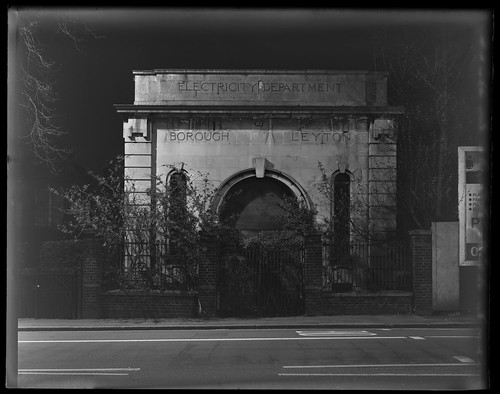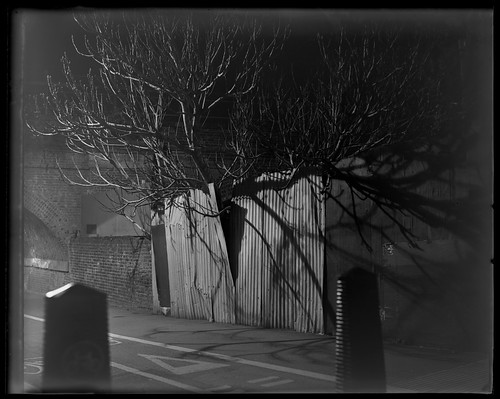 |
| Electricity Substation, MPP Micro-Technical Mk VI, Ilford G.30 Chromatic Plate |
Having had some success with using a number of different types of vintage glass plates, I wanted to design a project to use them for. These glass plates are a finite resource, although they do appear frequently in online auctions (photographic plates
are still manufactured, but only for very specialist applications, and are prohibitively expensive). So, to use those plates I've already collected, I decided to undertake an ongoing project of urban night photography. There are a couple of examples in my post on
Ilford G.30 plates, although it was only when photographing the
disused cinema that the idea began to formulate.
 |
| Mimosa Porträtyp-Antihalo plate test |
With the exception of the Ilford G.30 plates, most of the plates I've used are from previously opened boxes, which does mean that there is a chance that contents may have been exposed to light at some stage in their history. This has only been the case with the Mimosa Porträtyp-Antihalo and Kodak B 40 plates, and it hasn't been all of the plates in the box. The Mimosa plates have nothing to date them securely, but these could be as old as 1930s-40s (
the box says these are "Made in Germany" and presumably date from before East and West Germany). I shot a test of these, which did come out with heavy fogging, and a number of Kodak plates. I have been systematically testing the plates in my
Icarette L with successive exposures to a get a rough idea of the exposure needed.
 |
| Kodak B 40 Fine-Grain Regular plate test |
 |
| Kodak B.4 Half-Tone plate test |
Some of the plates were originally for specialist applications, such as the Kodak B.4 Half-Tone plates, which as the name suggests, are high-contrast; many of the plates are not panchromatic, meaning that they can be loaded under a safelight, useful when there are loose plates in a box, making it easier t to determine which is the emulsion side. The safelight for the B.4 Half-Tone plates is given as 'OB'. Although OB doesn't appear on Kodak's
safelight data sheet, all the other 'O' series safelights are yellow. Considering the given safelight for these plates would be yellow, I made a guess that these are blue-sensitive only and loaded the plate under a red safelight. (Given my limited experience of different Kodak plates, panchromatic plates have a 'P' prefix, orthochromatic, 'O', so it would make sense for blue-sensitive to have 'B' - although I have found nothing to confirm this).
 |
| Kodak P 300 Special Rapid Panchromatic and P.1600 Panchro-Royal plates |
Two previously unopened boxes of plates I've made tests from are Kodak P 300 Special Rapid Panchromatic and P.1600 Panchro-Royal plates. As sealed boxes, these have information sheets inside, useful for the original meter settings and developing times: I've posted the
P 300 Special Rapid Panchromatic sheet and the
P.1600 Panchro-Royal sheet on Flickr. I've generally been using a starting point of increasing the exposure by 1 or 2 stops for the tests to compensate for the age of the plates, then the succesive exposures provide a more accurate exposure index to shoot with. Although both boxes were sealed, the Panchro-Royal plates have not aged as well as the Special Rapid plates, which are 'tropically hardened': this may or may not have an effect on the longevity of the emulsion.
 |
| Kodak P 300 Special Rapid Panchromatic plate test |
 |
| Kodak P.1600 Panchro-Royal plate test |
Shooting them at night adds an extra layer of difficulty and not only in terms of getting the exposure right (I haven't touched on
reciprocity law failure). The shot of the ghost train below proved hard to focus, even with the lens wide open at f4.5: the image on the ground glass screen was very dull, simply because the scene was at a considerable distance from any streetlights. Stopping down to f5.6, I calculated a ten minute exposure. Using a smaller aperture with greater depth of field would have meant that the accuracy of focus would be less critical, but this would have given much longer exposure times. The 4x5
G.30 Chromatic glass plates (shot with my
MPP Micro-Technical Mk VI camera) are still the best plates I've used, and both subjects using them on this post were well-lit, in terms of night photography.
 |
| Branches and Shadows, MPP Micro-Technical Mk VI, Ilford G.30 Chromatic plate |
 |
| Concrete Stairwell, Wallace Heaton Zodel with Kodak O.250 plate |
 |
| Ghost Train, Ica Icarette L with Kodak O.250 plate |










Good work, lovely nightshots. Yes, I have found that opened boxes of plates have usually been fogged to a greater or lesser degree. As I previously posted, I have also had good results with the Ilford G.30 plates, and lately with Ilford HP3, and with some apparently rare Agfa Avipan 5"x7" plates. These I have seen at online auction at great expense - about £10-£12 a plate in boxes of a dozen - an investment beyond me! You are obviously intrepid to attempt night photography with plates. They look great.
ReplyDeleteThanks for your comments. The Ilford G.30 plates do seem to have lasted well, possibly in part to the slow speed of the emulsion. I've just started on my third box (out of four I've currently got) of them. I've also had some good results with HP3.
ReplyDeleteFor £10-£12 a plate, one may as well buy new plates from the few available sources!
And what are the few available sources? Not that I can afford that, but pending a lottery win...
ReplyDeleteLumiere sells Wephota MO1 Microplates, starting at 59.90 euros for 12 plates in 6.5x9 size/99.90 euros for 9x12, plus shipping: http://www.lumiere-shop.de/index.php?page=categorie&cat=240
DeleteSlavich makes plates for holography and radiography, no indications of prices: http://www.slavich.com/emulsions_for-photomasks-radiography
Via http://www.integraf.com/hologram_film_vrp.htm 25 Slavich 4x5 inch plates are $250 - $10 a plate, plus shipping of course.
Until very recently - this month I believe - Macodirect.de were selling APX 100 glass plates, but these are no longer on their website.
Ilford also make nuclear emulsion plates, conceivably usable for pictorial photography, I haven't found any sites where it is possible to buy these direct.